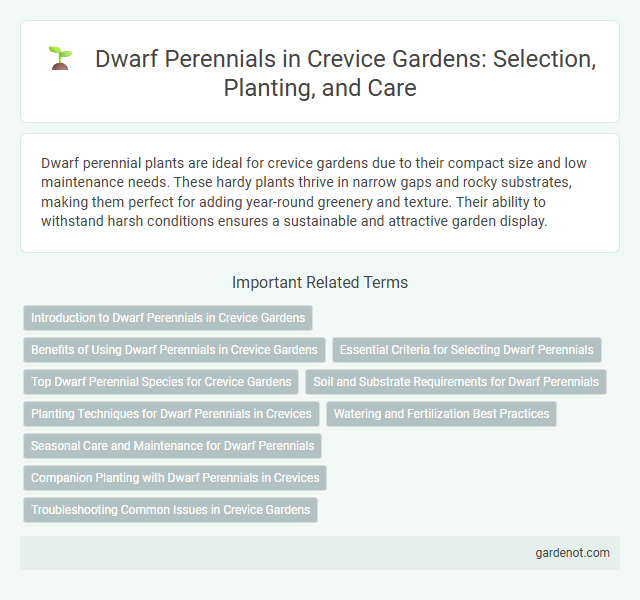Dwarf perennial plants are ideal for crevice gardens due to their compact size and low maintenance needs. These hardy plants thrive in narrow gaps and rocky substrates, making them perfect for adding year-round greenery and texture. Their ability to withstand harsh conditions ensures a sustainable and attractive garden display.
Introduction to Dwarf Perennials in Crevice Gardens
Dwarf perennials are ideal for crevice gardens due to their compact size and resilience, thriving in narrow cracks and minimal soil. These plants often exhibit slow growth and deep root systems, enabling them to withstand harsh conditions such as drought and temperature fluctuations commonly found in crevice environments. Their diverse foliage and flowering patterns enhance the aesthetic appeal while promoting biodiversity in these unique garden settings.
Benefits of Using Dwarf Perennials in Crevice Gardens
Dwarf perennials in crevice gardens optimize limited space by providing year-round greenery with minimal maintenance, enhancing soil stability and preventing erosion. Their compact growth habit ensures they fit seamlessly into narrow gaps, promoting biodiversity by attracting pollinators such as bees and butterflies. These resilient plants adapt well to rocky, well-drained conditions, making them ideal for sustainable crevice garden designs.
Essential Criteria for Selecting Dwarf Perennials
Dwarf perennials for crevice gardens must exhibit strong adaptability to shallow, rocky substrates and low nutrient availability to thrive in confined spaces. Prioritize species with compact growth habits and deep root systems that maximize stability and moisture absorption in crevices. Cold hardiness, drought tolerance, and minimal maintenance requirements are essential criteria for ensuring year-round resilience and aesthetic appeal in crevice garden environments.
Top Dwarf Perennial Species for Crevice Gardens
Dwarf perennials such as Saxifraga oppositifolia, Phlox subulata, and Alyssum montanum are top choices for crevice gardens due to their compact growth and ability to thrive in rocky, well-drained environments. These species exhibit exceptional drought tolerance and develop vibrant blooms, enhancing the texture and color contrast in narrow rock gaps. Their low maintenance requirements and resilience make them ideal for creating sustainable and visually appealing alpine-style crevice garden designs.
Soil and Substrate Requirements for Dwarf Perennials
Dwarf perennials thrive in well-draining, gritty soils that mimic their natural alpine or rocky habitats, ensuring roots do not retain excess moisture which can cause rot. A substrate blend of coarse sand, fine gravel, and organic matter such as compost supports optimal aeration and nutrient availability. Maintaining a slightly acidic to neutral pH (5.5-7.0) enhances nutrient uptake and promotes healthy growth in crevice garden environments.
Planting Techniques for Dwarf Perennials in Crevices
Planting dwarf perennials in crevices requires careful soil preparation and selecting species with shallow root systems for optimal growth. Use a well-draining, gritty substrate mixed with organic matter to mimic natural rocky habitats and prevent waterlogging. Position plants strategically to ensure adequate sunlight exposure while maintaining spacing for airflow and root expansion.
Watering and Fertilization Best Practices
Dwarf perennials in crevice gardens require minimal watering, ideally allowing the soil to dry out between sessions to prevent root rot, as these plants thrive in well-drained conditions. Fertilization should be light and infrequent, using a balanced, slow-release fertilizer diluted to half strength once during the growing season to avoid nutrient overload. Maintaining proper watering and fertilization practices enhances the health and longevity of dwarf perennials in the challenging environment of crevice gardens.
Seasonal Care and Maintenance for Dwarf Perennials
Dwarf perennials in crevice gardens require precise seasonal care to thrive, including mulching in winter to protect roots from frost and trimming dead foliage in early spring to encourage healthy new growth. Regular watering during dry periods prevents stress, while avoiding overwatering preserves root health in the narrow crevices. Fertilizing lightly in spring with a balanced, slow-release fertilizer supports vibrant blooms and compact foliage throughout the growing season.
Companion Planting with Dwarf Perennials in Crevices
Dwarf perennials thrive in crevice gardens by utilizing narrow gaps between rocks for root growth, which also benefits companion planting through minimized resource competition. Ideal companions include creeping thyme, sedums, and dwarf saxifrage, as these plants share similar moisture and sunlight requirements, promoting healthy development. Strategic planting in crevices enhances biodiversity and creates a resilient microenvironment that supports sustained growth and reduces maintenance needs.
Troubleshooting Common Issues in Crevice Gardens
Dwarf perennials in crevice gardens often face challenges such as poor drainage and root rot due to compacted soil between stones. Ensuring well-drained soil with ample gritty substrate promotes healthy root systems and prevents moisture buildup. Regularly inspecting plants for signs of pest infestation or fungal disease allows for prompt treatment, maintaining the vitality of dwarf perennials in crevice garden environments.
Dwarf perennial Infographic

 gardenot.com
gardenot.com